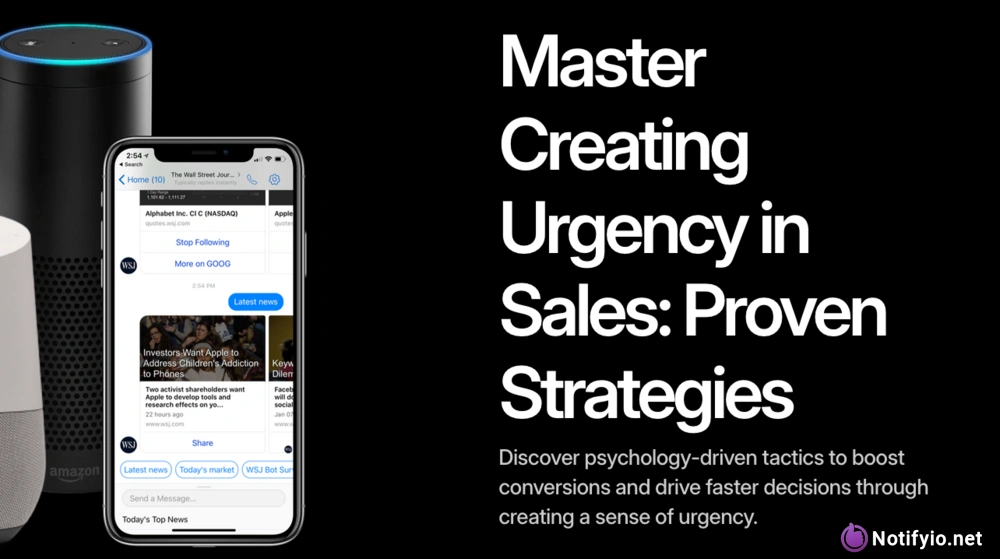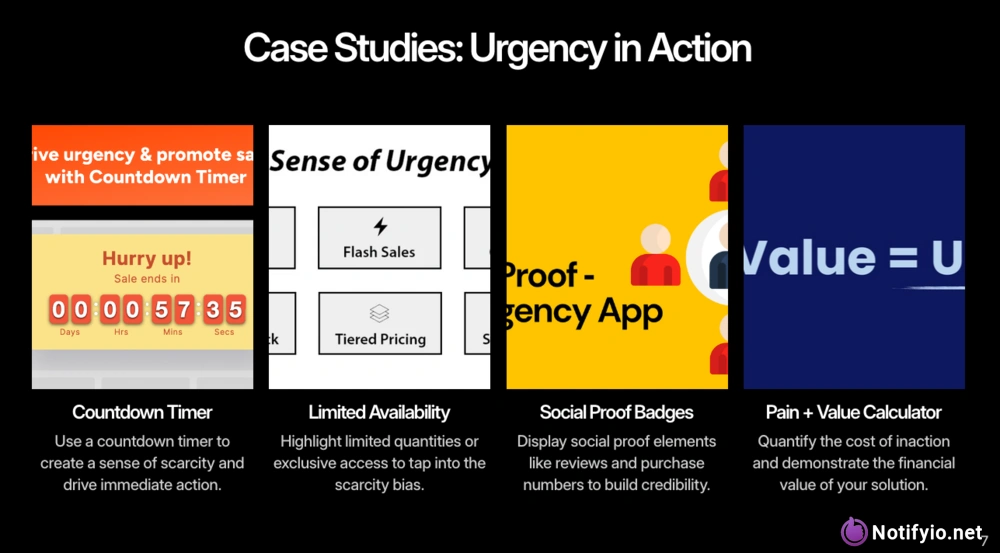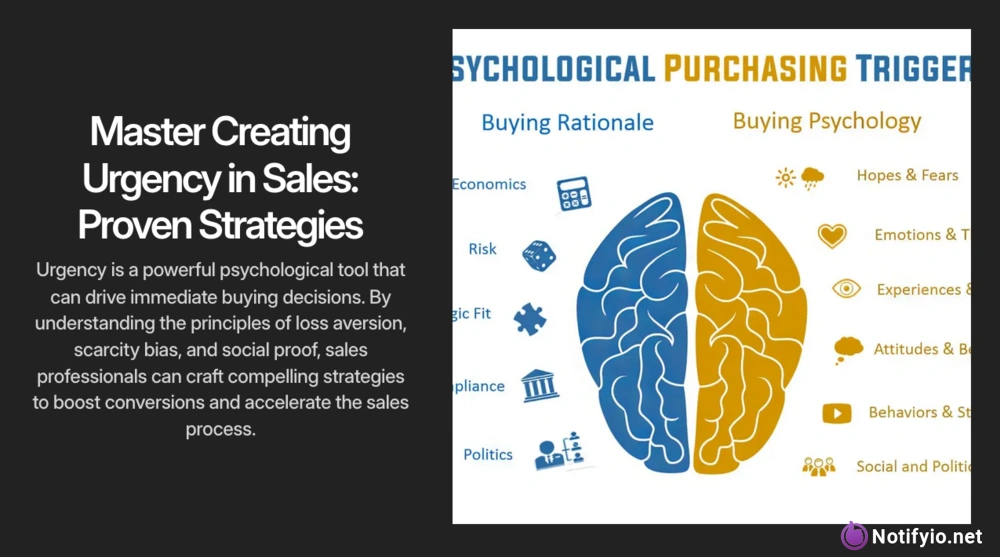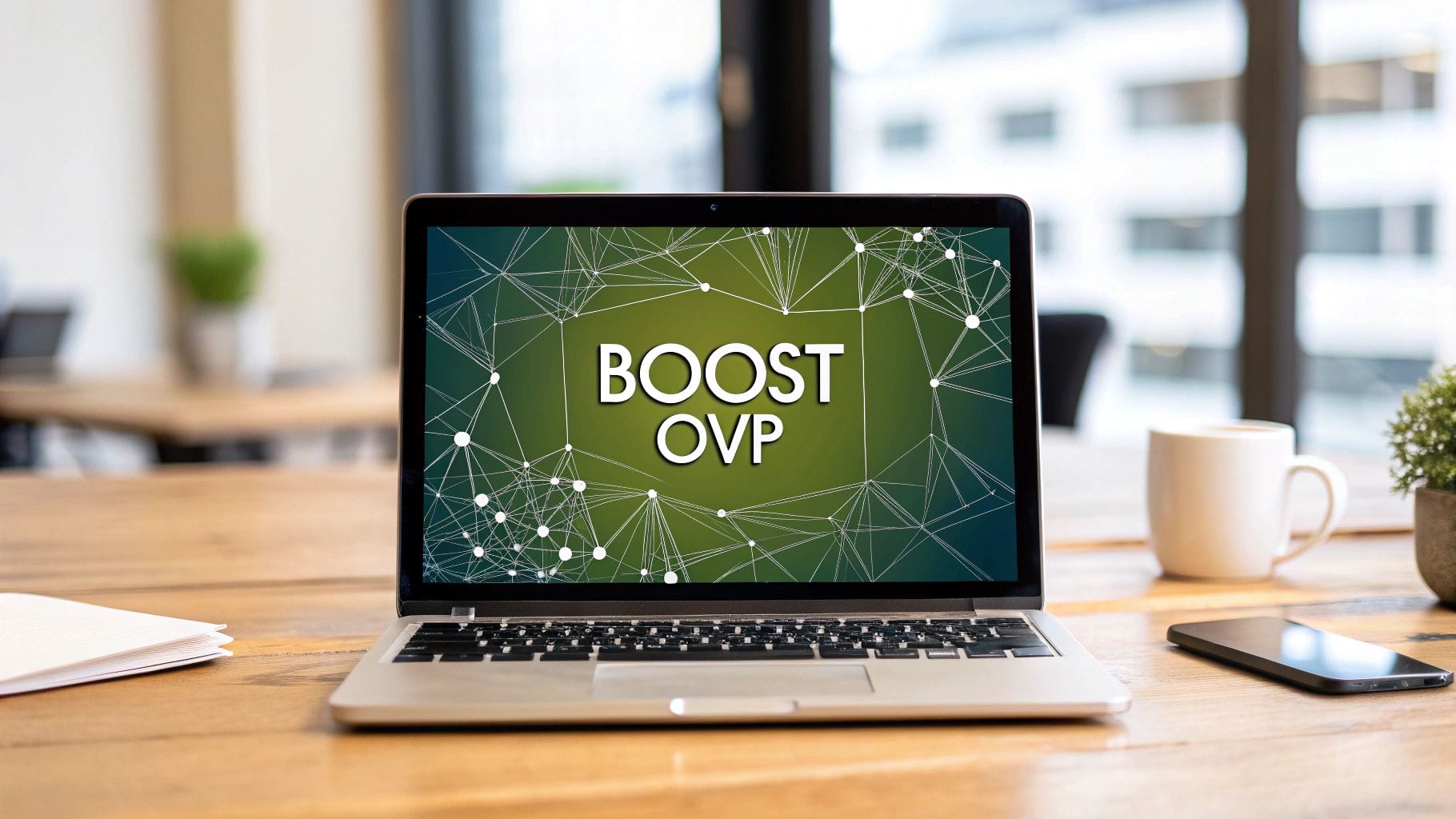The Psychology Behind Why Urgency Drives Buying Decisions

Creating urgency in sales can be a powerful strategy. But understanding the psychology behind it is key to its effectiveness. These principles tap into our core behaviors and motivations, allowing you to connect with prospects on a deeper level.
Loss Aversion and the Fear of Missing Out
One of the primary drivers is loss aversion. This principle highlights that the pain of losing something is stronger than the joy of gaining something equivalent. Think about it: customers are more driven to avoid missing a deal than to acquire the product itself.
This ties directly into the fear of missing out (FOMO). FOMO is a powerful motivator that significantly shapes buying decisions. Limited-time offers are a prime example of how scarcity creates FOMO.
Marketers understand this and use tactics like countdown timers and limited-time offers. These tactics can boost conversions by up to 332%. E-commerce platforms, for instance, frequently see checkout rates jump by 20-30% during flash sales using visible countdowns.
A 2025 CXL analysis revealed that urgency taps into this loss aversion. Customers prioritize avoiding a missed opportunity over the potential gains. This explains why phrases like “24-hour deal” perform better than generic promotions. One SaaS company, for example, saw sign-ups increase by 45% just by adding scarcity messaging like “Only 3 seats left!” For more information on creating urgency, visit CXL.
Scarcity Bias: When Less Is More
The scarcity bias is another crucial principle. We tend to value things more when they are less available. This perception of scarcity boosts the perceived value of a product, making it more appealing to potential buyers.

Limited quantities, exclusive access, and time-bound offers all trigger this bias. However, it’s important to use scarcity ethically and avoid manufacturing artificial scarcity, as this can erode your credibility.
The Power of Social Proof
Social proof significantly strengthens urgency. Seeing others take action often encourages us to do the same. This is particularly true with limited-time opportunities or perceived scarcity.
Testimonials, reviews, and displaying purchase numbers all build social proof. These tactics amplify the sense of urgency to buy, particularly in online sales.
To better illustrate the psychological principles at play, take a look at the table below:
| Psychological Principle | How It Works | Effect on Buying Behavior |
|---|---|---|
| Loss Aversion | Fear of missing out motivates action. | Increased likelihood of immediate purchase. |
| Scarcity Bias | Limited availability increases perceived value. | Higher desire for the scarce item. |
| Social Proof | Others’ actions validate the purchase. | Encourages following the crowd and buying now. |
This table outlines the key psychological principles that make urgency effective in sales contexts. By understanding these drivers, you can craft effective, urgency-driven sales strategies that resonate authentically with potential buyers. This leads to more conversions and builds stronger customer relationships.
Quantifying the Cost of Delay: The Pain + Value Equation

Understanding the psychology of urgency in sales is important. But, turning that understanding into financial terms is what truly motivates decision-makers. This means shifting the focus from a vague fear of missing out to concrete calculations. Think lost revenue, wasted resources, and missed opportunities.
For example, instead of simply listing the advantages of new software, quantify the cost of not having it.
This is where the Pain + Value Equation comes in. It helps potential customers see the financial impact of inaction. This makes the need to buy feel like a smart business decision, not a sales tactic. The equation has two key parts: quantifying existing problems and showing the value of your solution.
Calculating the Cost of Inaction
The first step in creating sales urgency is understanding the status quo’s cost. This means figuring out the financial impact of current challenges.
These challenges could be lost revenue from inefficient processes, expenses from outdated technology, or the cost of reacting to problems instead of preventing them.
For example, if a prospect has high customer churn, calculate the lifetime value of lost customers. Present this as a real cost of inaction. Highlight the potential risks and consequences of ignoring the problem. This clearly shows the potential negative impact on their profits.
Demonstrating the Value Proposition
After quantifying the pain points, show how your solution addresses them and delivers real value. This isn’t just about features. It’s about how those features lead to financial benefits. You need to quantify the return on investment (ROI).
For example, if your product increases efficiency, calculate the time saved and the resulting financial gains. If your service reduces risk, quantify the potential savings from avoiding problems. This makes your solution’s value clear and compelling.
The ‘Pain + Value = Urgency’ formula, highlighted by MEDDICC in 2022, focuses on this. Sales teams report 15-25% faster deal cycles when solutions are tied to specific costs. For example, framing a $50,000 software purchase as a way to recover $200,000 in annual revenue loss.
Cybersecurity companies often highlight potential breach losses ($4.35 million average in 2022, per IBM) to justify investments. One case study showed a manufacturing client sped up their buying process by 6 weeks after seeing projected $500,000/month operational losses without the proposed solution.

To help illustrate this concept, consider the following framework:
Cost of Inaction Calculator Framework
A framework for calculating and presenting the financial impact of delaying purchase decisions.
| Cost Category | Calculation Method | Typical Impact Range | How to Present to Prospects |
|---|---|---|---|
| Lost Revenue | Lost customers * Average Customer Lifetime Value | $10,000 – $1,000,000+ | Present churn rate data and the financial impact of each lost customer. |
| Inefficient Processes | Wasted time * Employee hourly rate | $5,000 – $500,000+ | Showcase how automation or streamlined workflows can save time and money. |
| Outdated Technology | Maintenance costs + Lost productivity due to downtime | $1,000 – $250,000+ | Highlight the costs of maintaining legacy systems and the benefits of upgrading. |
| Reactive Problem Solving | Cost of emergency repairs/replacements + Lost productivity | $2,000 – $100,000+ | Illustrate the financial benefits of proactive solutions and preventative measures. |
This table provides a starting point for quantifying the potential costs associated with inaction. By tailoring these calculations to the specific circumstances of each prospect, you can create a more compelling and personalized argument for investing in your solution.
Presenting the ROI Timeline
Finally, present a clear ROI timeline. Show how quickly a prospect can expect a return on their investment. This reinforces the urgency by showing the potential for fast financial gains.
This timeline must be realistic and data-driven. This boosts your credibility. By combining the cost of inaction with the value of your solution, you make a strong case for immediate action.
Time-Based Urgency Techniques That Actually Work

Forget generic “limited-time offers.” Truly effective time-based urgency requires a deeper understanding of how to create offers that feel valuable, not manipulative. Let’s explore how to use time constraints strategically.
The Power of the Deadline
Deadlines can be incredibly effective motivators. They create a clear call to action, encouraging potential customers to make a decision. The key is to make the deadline believable and relevant.
This means considering the typical buying cycle of your product and how long your customer needs to make an informed decision. A 72-hour flash sale might work for a small purchase, but it’s likely ineffective for something like complex enterprise software.
Time-Bound Bonuses and Incentives
Sweeten the deal and boost the appeal of your time-sensitive offers by adding bonuses and incentives. Think free shipping, a complimentary upgrade, or exclusive access to valuable content.
These extras increase the perceived value, making the offer more attractive. It’s a win-win: customers get added benefits, and you see increased sales.
How Incentives Impact Conversions
Deadline-driven incentives, like limited-time bonuses, can have a real impact on conversion rates. These incentives can improve conversions by 10-50%, depending on the specific industry.
For example, a 2025 Deadline Funnel study showed a travel agency boosting bookings by 34% using 72-hour discounts with perks like free room upgrades. Urgency tactics often perform especially well in highly competitive markets.

Communicating Deadlines Effectively
How you communicate your deadlines is just as crucial as the deadlines themselves. Transparency and clarity are essential. State the deadline clearly, explaining what happens if it’s missed.
Visual cues like countdown timers can emphasize the limited time. Avoid high-pressure sales tactics, which can push customers away. Instead, focus on the benefits they’ll gain by acting fast.
Global Impact of Urgency
The success of urgency tactics can vary around the world. In 2023, 70% of Chinese shoppers on Alibaba’s Singles’ Day made purchases motivated by countdown timers. This resulted in a staggering $56 billion in sales within 24 hours.
Amazon’s Prime Day events, also using urgency principles, routinely generate billion-dollar hourly sales. This shows how powerful well-executed urgency can be across different cultures.
Flash Sales and Limited-Time Promotions
Flash sales and limited-time promotions are tried-and-true methods of creating urgency. They generate excitement and encourage immediate purchases.
These short bursts of sales activity can be especially useful for clearing out excess inventory, introducing new products, or driving sales during slower periods. Just remember to use them strategically. Too many sales can train customers to wait for discounts.
Leveraging Authentic Scarcity to Drive Decision Momentum

While time-sensitive deals can be effective, authentic scarcity offers a different kind of persuasive power. Instead of manufactured deadlines, this approach focuses on genuine limitations. This builds trust with potential customers and reinforces the perceived value of your products or services. It’s especially impactful for businesses offering unique or specialized items.
Understanding Genuine Constraints
Authentic scarcity relies on real limitations in your business. This could be anything from limited production capacity to exclusive access to specific materials or a finite number of client slots for a service.
For example, a furniture maker specializing in handcrafted pieces might have limited production capacity due to the time-intensive nature of their craft. A software company launching a new product might offer a beta program with a limited number of participant spots. These are real-world constraints, not manufactured marketing tactics.
Communicating Scarcity Effectively
Transparency and honesty are key to communicating authentic scarcity effectively. Clearly explain the reasons behind the limitations. This helps potential customers understand the true nature of the scarcity, building confidence in your brand.
Avoid generic phrases like “limited availability.” Instead, explain why availability is limited. For example, “Due to high demand and our commitment to hand-stitching each leather bag, we only have five units left.” This approach reinforces the product’s value and craftsmanship.

Industry-Specific Approaches to Scarcity
Different business models require tailored approaches to scarcity. A SaaS business might highlight limited spots in a premium onboarding program. An e-commerce store could emphasize limited-edition products or exclusive bundles. A consultant might promote a limited number of available consultation slots each month.
Aligning your scarcity strategy with your specific industry strengthens its impact. This makes the scarcity feel more relevant and genuine, increasing buyer motivation.
Presenting Real-Time Availability Data
Whenever possible, display real-time availability data. This reinforces the authenticity of your scarcity message. For an e-commerce site, this could involve showing the number of remaining products. For a workshop or event, display the number of remaining spots.
This transparent approach builds trust and underscores the urgency to act. Consider implementing a live counter on your website or providing a personalized update during a sales call.
Maintaining Relationship Integrity
While creating a sense of urgency is important, maintaining positive customer relationships is paramount. Authentic scarcity should never feel manipulative. The goal is to empower customers to make informed decisions, not to pressure them into buying something they don’t need.
By focusing on genuine limitations and communicating transparently, you build trust and foster stronger customer relationships. This approach ensures your urgency tactics enhance, rather than damage, your brand reputation, contributing to long-term success.
Conversation Frameworks That Create Natural Urgency
Top-performing salespeople understand creating urgency isn’t about pushy sales tactics. Instead, it’s about guiding conversations so prospects recognize the value of acting sooner rather than later. This involves specific questioning techniques and response frameworks designed to gently nudge prospects toward time-sensitive decisions.
Questioning Techniques to Uncover Urgency Drivers
Forget generic pressure. Focus on understanding each prospect’s individual urgency drivers. During discovery calls, ask open-ended questions to uncover their pain points and priorities.
For example, instead of asking, “What are your challenges?”, try something like, “What’s keeping you up at night regarding [area related to your product]?” This encourages more detailed insights into their motivations.
Further probing questions, like, “What’s the impact of this challenge on your business?” or “What happens if this problem isn’t resolved soon?” help quantify the cost of inaction. This makes the urgency feel genuine, not manufactured. These insights provide the basis for presenting your solution as the answer to their immediate needs.
Language Patterns That Subtly Emphasize Time Sensitivity
After identifying their urgency drivers, subtly incorporate time-sensitive language into your responses. For instance, if a prospect mentions losing revenue due to an inefficient process, you could respond with, “Given the current losses you’re experiencing, every day without a solution like [your product] adds up. Optimizing this now could mean recouping significant revenue within the next quarter.” This frames the purchase as a timely investment with tangible returns, naturally creating urgency.
Steer clear of generic phrases like “limited-time offer.” Instead, use language connecting their specific needs to the benefits of acting quickly. Phrases like “Based on your current situation, implementing this now could mean…” or “To capitalize on this opportunity before [external factor, e.g., competitor move, market shift], it’s best to…” create a sense of timely opportunity without resorting to high-pressure sales tactics.

Response Frameworks for Objection Handling
Objections will happen, even with well-crafted questions and language. Prepare response frameworks that address concerns while reinforcing urgency. For example, if a prospect hesitates due to budget constraints, you might say, “I understand budget is a key consideration. However, given the potential ROI we discussed, delaying this decision could cost you more in the long run. Let’s explore flexible payment options that make this investment viable now.”
This acknowledges their concern while re-emphasizing the financial impact of inaction. It also offers a solution that allows them to move forward comfortably. This collaborative approach maintains trust throughout the sales process, especially when discussing sensitive topics like budget.
Adapting to Virtual Selling Environments
Creating urgency in virtual settings requires a nuanced approach. Without in-person cues, building rapport and conveying sincerity are even more critical.
In video calls using platforms like Zoom, use clear and concise language. Use screen sharing to present compelling data visualizing the cost of delay and the ROI of your solution. Follow up promptly with personalized emails summarizing key discussion points and reiterating the benefits of timely action.
This proactive approach keeps the conversation moving forward and reinforces the value proposition, even after the call ends. By tailoring your communication to the virtual environment, you can create authentic urgency that resonates with remote prospects.
Measuring and Optimizing Your Urgency Strategy
Creating a sense of urgency is key to driving conversions, but are your efforts truly effective? It’s essential to move beyond basic conversion tracking and delve into a more comprehensive analysis of your urgency strategies. This means understanding your target audience’s motivations and continually refining your approach based on data and feedback.
Key Performance Indicators (KPIs) for Urgency
Several KPIs can help you measure the effectiveness of your urgency tactics. Conversion rates are a natural starting point. An increase in conversions after implementing a new urgency strategy is a positive indicator. However, it’s important to look beyond the initial sale.
Track metrics like average order value and customer lifetime value. These provide a more complete view of how your urgency techniques influence overall revenue. Also, keep a close eye on cart abandonment rates. A reduction in abandoned carts suggests your urgency messaging is prompting customers to finalize their purchases.

A/B Testing: Refining Your Approach
A/B testing is an essential tool for optimizing urgency. Experiment with different versions of your messaging, time limits, and scarcity cues. For example, compare a “24-hour sale” against a “limited quantity” offer.
Testing different elements helps you identify what resonates with your audience and fine-tune your approach for maximum impact. This iterative process is essential for continuous improvement and helps you avoid using strategies that simply aren’t effective.
Analyzing Customer Behavior
Go beyond A/B testing by examining how customers interact with your website or sales process. Identify trends that show whether your urgency techniques are successful. If customers add items to their carts but don’t complete the purchase, perhaps your checkout page needs stronger urgency messaging.
Look for activity spikes related to specific urgency campaigns. This can provide valuable information on the effectiveness of different tactics. Also, analyze customer feedback from surveys and reviews to understand their perspective on your urgency methods. This qualitative data complements your quantitative analysis and offers a more holistic understanding of your strategy.
Identifying Warning Signs and Avoiding Backfires
While urgency can be a powerful tool, it’s important to recognize when your tactics might be having the opposite effect. If you notice a decline in customer trust or an increase in negative reviews, reassess your strategy. Your messaging might be too aggressive, or your scarcity claims might feel disingenuous.
Overuse can also lead to urgency fatigue, where customers become desensitized to your messaging and begin to tune it out. This can weaken future campaigns. Therefore, strategic and measured use of urgency is crucial.
Building a Framework for Continuous Improvement
Measuring and optimizing your urgency strategy is an ongoing endeavor. By tracking key metrics, analyzing customer behavior, and consistently testing different tactics, you can build a strong foundation for authentic and effective urgency.
This iterative process helps you avoid common mistakes and refine your methods, creating campaigns that drive immediate sales and contribute to long-term growth and stronger customer relationships. For further guidance on optimizing your marketing strategies and utilizing social proof and conversion optimization, visit Notifyio for practical insights and expert advice.




Leave a Reply